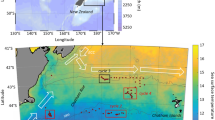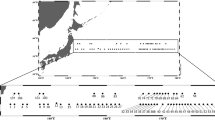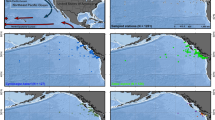Abstract
Depth-stratified vertical sampling was carried out during the New Zealand International Polar Year cruise to the Ross Sea on board the RV Tangaroa in February–March 2008. The distribution (horizontal and vertical), density and population biology of Salpa thompsoni were investigated. Salps were found at two of the four major sampling locations, e.g. near the continental slope of the Ross Sea and in the vicinity of seamounts to the north of the Ross Sea. Both abundance and biomass of S. thompsoni were highest near the seamounts in the Antarctic Circumpolar Current reaching ~2,500 ind 1,000 m−3 and 8.2 g dry wt 1,000 m−3 in the water column sampled. The data showed that S. thompsoni populations were able to utilize horizontal and vertical discontinuities in water column structure, in particular the warm Circumpolar Deep Water (CDW), to persist in the high Antarctic. Although salps appeared to continue migrating to the surface colder layers to feed, both aggregate chain and young embryo release seem to be restricted to the CDW. This study for the first time has provided evidence that low Antarctic salp species may successfully reproduce in the hostile high Antarctic realm.











Similar content being viewed by others
References
Atkinson A, Siegel V, Pakhomov EA, Rothery P (2004) Long-term decline in krill stock and increase in salps within the Southern Ocean. Nature 432:100–103
Casareto BE, Nemoto T (1986) Salps of the Southern ocean (Australian sector) during the 1983–84 summer, with special reference to the species Salpa thompsoni. Mem Natl Inst Polar Res 40:221–239
Casareto BE, Nemoto T (1987) Latitudinal variation of the number of muscle fibres in Sapla thompsoni (Tunicata, Thaliacea) in the Southern Ocean, implications for the validity of the species Salpa gerlachei. Proc NIPR Symp Polar Biol 1:90–104
Catalán IA, Morales-Nin B, Company JB, Rotllant G, Palomera I, Emelianov M (2008) Environmental influences on zooplankton and micronekton distribution in the Bransfield Strait and adjacent waters. Polar Biol 31:691–707
Chiba S, Ishimaru T, Hosie GW, Wright SW (1999) Population structure change of Salpa thompsoni from austral mid-summer to autumn. Polar Biol 22:341–349
Daponte MC, Capitanio FL, Esnal GB (2001) A mechanism for swarming in the tunicate Salpa thompsoni (Foxton, 1961). Antarct Sci 13:240–245
de la Mare WL (1997) Abrupt mid-twentieth-century decline in Antarctic sea-ice extent from whaling records. Nature 389:57–60
de la Mare WK (2009) Changes in Antarctic sea-ice extent from direct historical observations and whaling records. Clim Change 92:461–493
Dubischar CD, Pakhomov EA, Bathmann U (2006) The tunicate Salpa thompsoni ecology in the Southern Ocean—II. Proximate and elemental composition. Mar Biol 149:629–632
Foxton P (1964) Salpa fusiformis Cuivier and related species. Discov Rep 32:1–32
Foxton P (1966) The distribution and life history of Salpa thompsoni Foxton with observations on a related species S. gerlachei Foxton. Discov Rep 34:1–116
Gili J-M, Rossi S, Pagès F, Orejas C, Teixidó N, López-González PJ, Arntz WE (2006) A new trophic link between the pelagic and benthic systems on the Antarctic shelf. Mar Ecol Prog Ser 322:43–49
Gille ST (2002) Warming of the Southern Ocean since the 1950s. Science 295:1275–1277
Gille ST (2008) Decadal-scale temperature trends in the Southern Hemisphere Ocean. J Climate 21:4749–4765
Hardy AC, Gunther ER (1935) The plankton of the South Georgia whaling ground and adjacent waters. Discov Rep 11:1–456
Hosie GW, Cochran TG, Pauly T, Beaumont KL, Wright SW, Kitchener JA (1997) Zooplankton community structure of Prydz Bay, Antarctica, January–February 1993. Proc NIPR Symp Polar Biol 10:90–133
Jacobs SS, Amos AF, Bruchhausen PM (1970) Ross Sea oceanography and Antarctic bottom water formation. Deep Sea Res 17:935–962
Klinck JM, Hofmann EE, Beardsley RC, Salihoglu B, Howard S (2004) Water-mass properties and circulation on the west Antarctic Peninsula continental shelf in austral fall and winter 2001. Deep Sea Res II 51:1925–1946
Krakatitsa VV, Karpenko GP, Pakhomov EA (1993) Distribution peculiarities of zooplankton depending on temperature stratification of the 1-metre surface water layer in the Cooperation Sea. In: Voronina NM (ed) Pelagic ecosystems of the Southern Ocean. Nauka Press, Moscow, pp 151–157
Le Fèvre J, Legendre L, Rivkin RB (1998) Fluxes of biogenic carbon in the Southern Ocean, roles of large microphagous zooplankton. J Mar Syst 17:325–345
Levitus A, Antonov JI, Boyer TP, Stephens C (2000) Warming of the World Ocean. Science 287:2225–2229
Loeb V, Siegel V, Holm-Hansen O, Hewitt R, Fraser W, Trivelpiece W, Trivelpiece S (1997) Effects of sea-ice extent and krill or salp dominance on the Antarctic food web. Nature 387:897–900
Moline MA, Claustre H, Frazer TK, Grzymski J, Schofield O, Vernet M (2000) Changes in phytoplankton assemblages along the Antarctic Peninsula and potential implications for the Antarctic food web. In: Davison W, Howard-Williams C, Broady P (eds) Antarctic ecosystems, models for wider ecological understanding. The Caxon Press, Christchurch, pp 263–271
Naganobu M, Nishiwaki S, Yasuma H, Matsukura R, Takao Y, Taki K, Hayashi T, Watanabe Y, Yabuki T, Yoda Y, Noiri Y, Kuga M, Yoshikawa K, Kokubun N, Murase H, Matsuoka K, Ito K (2006) Interactions between oceanography, krill and baleen whales in the Ross Sea and adjacent waters: an overview of Kaiyo Maru-JARPA joint survey in 2004/05. Japanese Whale Research Program under Special Permit in the Antarctic (JARPA) Review Meeting, Paper SC/D06/J23. http://www.icrwhale.org/eng/SC-D06-J23.pdf
Nicol A, Pauly T, Bindoff NL, Wright S, Thlele D, Hosie GW, Strutton PG, Woehler E (2000) Ocean circulation off east Antarctica affects ecosystem structure and sea-ice extent. Nature 406:504–507
Nishikawa J, Tsuda A (2001) Diel vertical migration of the tunicate Salpa thompsoni in the Southern Ocean during summer. Polar Biol 24:299–302
Orsi AH, Wiederwohl CL (2009) A recount of Ross Sea waters. Deep Sea Res II 56:78–795
Orsi AH, Whitworth T III, Nowlin WD Jr (1995) On the meridional extent and fronts of the Antarctic Circumpolar Current. Deep Sea Res I 42:641–673
Pakhomov EA (1993) Vertical distribution and diel migrations of Antarctic macroplankton. In: Voronina NM (ed) Pelagic ecosystems of the Southern Ocean. Nauka Press, Moscow, pp 146–150
Pakhomov EA (1994) Diel vertical migrations of Antarctic macroplankton. Salpidae, Ctenophora, Coelenterata, Chaetognatha, Polychaeta, Pteropoda. Oceanology 33:510–511
Pakhomov EA, Grachev DG, Trotsenko BG (1994) Distribution and composition of macroplankton communities in the Lazarev Sea (Antarctic). Oceanology 33:635–642
Pakhomov EA, Froneman PW, Perissinotto R (2002) Salp/krill interactions in the Southern Ocean, spatial segregation and implications for the carbon flux. Deep Sea Res II 49:1881–1907
Pakhomov EA, Dubischar CD, Strass V, Brichta M, Bathmann U (2006) The tunicate Salpa thompsoni ecology in the Southern Ocean—I. Distribution, biomass, demography and feeding ecophysiology. Mar Biol 149:609–623
Pakhomov EA, Dubischar CD, Hunt BPV, Strass V, Cisewski B, Siegel V, von Harbou L, Gurney L, Kitchener J, Bathmann U (in review) Pelagic tunicates in the Lazarev Sea, Southern Ocean. Deep Sea Res II
Park C, Wormuth JH (1993) Distribution of Antarctic zooplankton around Elephant Island during the austral summers of 1988, 1989, and 1990. Polar Biol 13:215–225
Perissinotto R, Pakhomov EA (1998a) Contribution of salps to carbon flux of marginal ice zone of the Lazarev Sea, Southern Ocean. Mar Biol 131:25–32
Perissinotto R, Pakhomov EA (1998b) The trophic role of the tunicate Salpa thompsoni in the Antarctic marine ecosystem. J Mar Syst 17:361–374
Phillips B, Kremer P, Madin LP (2009) Defecation by Salpa thompsoni and its contribution to vertical flux in the Southern Ocean. Mar Biol 156:455–467
Piatkowski U (1985) Distribution, abundance and diurnal migration of macrozooplankton in Antarctic waters. Meeresforsch 30:262–279
Picco P, Bergamasco A, Demicheli L, Manzella G, Meloni R, Paschini E (2000) Large-scale circulation features in the central and western Ross Sea (Antarctica). Ross Sea Ecology. Springer, New York, pp 95–105
Rickard GJ, Roberts MJ, Williams MJM, Dunn A, Smith MH (2010) Mean circulation and hydrography in the Ross Sea sector, Southern Ocean: representation in numerical models. Antarct Sci. doi: 10.1017/S0954102010000246
Rignot EJ, Jacobs SS (2002) Rapid bottom melting widespread near Antarctic ice sheet grounding lines. Science 296:2020–2023
Russo A (2000) Water mass characteristics during the ROSSMIZE cruise (Western sector of the Ross Sea, November–December 1994). Ross Sea Ecology. Springer, New York, pp 83–93
Shepherd A, Wingham DJ, Mansley AD, Corr HFJ (2001) Inland thinning of Pine Island Glacier, West Antarctica. Science 291:862–864
Shepherd A, Wingham DJ, Rignot E (2004) Warm Ocean is eroding West Antarctic ice sheet. Geophys Res Lett 31:L23402. doi:10.1029/2004GL021106
Siegel V, Skibowski A, Harm U (1992) Community structure of the epipelagic zooplankton community under the sea-ice of the northern Weddell Sea. Polar Biol 12:15–24
Smedsrud LH (2004) Warming of the deep water in the Weddell Sea along Greenwich meridian, 1977–2001. Deep Sea Res I 52:241–258
Voronina NM (1998) Comparative abundance and distribution of major filter-feeders in the Antarctic pelagic zone. J Mar Syst 17:375–390
Walsh JJ, Dieterle DA, Lenes J (2001) A numerical analysis of carbon dynamics of the Southern Ocean phytoplankton community, the roles of light and grazing in effecting both sequestration of atmospheric CO2 and food availability to larval krill. Deep Sea Res I 48:1–48
Acknowledgments
We would like to thank the captain and crew of the RV Tangaroa for invaluable help during the IPY-CAML sampling program and our colleagues for kind assistance in sample collections. The surveys were financially supported by the NIWA. Finally, NIWA (New Zealand), University of British Columbia (Canada), Alfred Wegener Institute for Polar and Marine Research and Alexander von Humboldt Foundation (Germany) are greatly acknowledged for providing funds and facilities allowing the completion of this study.
Author information
Authors and Affiliations
Corresponding author
Rights and permissions
About this article
Cite this article
Pakhomov, E.A., Hall, J., Williams, M.J.M. et al. Biology of Salpa thompsoni in waters adjacent to the Ross Sea, Southern Ocean, during austral summer 2008. Polar Biol 34, 257–271 (2011). https://doi.org/10.1007/s00300-010-0878-9
Received:
Revised:
Accepted:
Published:
Issue Date:
DOI: https://doi.org/10.1007/s00300-010-0878-9




